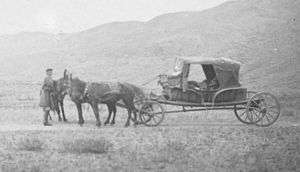Tarantass
The tarantass is a four-wheeled horse-drawn vehicle on a long longitudinal frame, reducing road jolting on long-distance travel. It was widely used in Russia in the first half of the 19th century. It generally carried four passengers. The origin of the word is not known: Fasmer's etymological dictionary[1] lists a number of variants from regional dialects to the ancient Indo-European roots with the mark "doubtful".

In 1840, author Vladimir Sollogub published a satirical novelette "Tarantass". The main hero of the story drove a team of three horses. In Jules Verne's novel Michael Strogoff it is one of the means of displacement.
The tarantass has been described as two long poles serving as parallel axles supporting a large basket forming a cup or bowl.[2] It is not suspended on springs, and generally has no benches. The vehicle is accessed by an external ladder. The interior is generally covered by straw, changed at intervals for cleanliness, upon which the passengers rest.[3]
An article in a Melbourne Australia newspaper dated 30/9/1887 refers to a journey by the Hon. James Campbell of a drive of 1800 miles by tarantass from Vladivostok to Moscow. [The distance from Vladivostok to Moscow is nearly 9000km, or over 5000 miles, so there is something wrong with this story.]
See also
References
- Макс Фасмер. The etymological dictionary of Russian. Translation from German and additions of member-correspondent АН the USSR O.N.Trubacheva. In four volumes. М.: Progress, 1986
- Century A.Sollogub. "Tarantass"
- Дюма A.Putevye of impression in Russia. М.: Ладомир, 1993